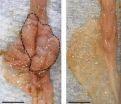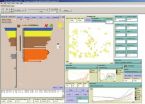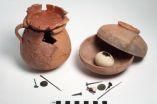(Press-News.org) LA JOLLA, CA – March 4, 2014 – Scientists at The Scripps Research Institute (TSRI) have invented small-molecule folding probes that enable them to quantify functional, normally folded and disease-associated misfolded conformations (shapes) of a protein-of-interest in cells under different conditions.
Scientists have long needed better tools for making such measurements in cells, because protein misfolding is a major cause of damage to tissues. Disorders that feature excessive protein misfolding afflict millions of people worldwide and include Alzheimer's and Parkinson's diseases, the systemic amyloidoses and prion ("mad cow-type") infections, as well as common enzyme deficiencies.
"This new probe technology should lead to a better understanding of how to fold misfolding-prone proteins in cells," said Jeffery W. Kelly, chair of TSRI's Department of Molecular and Experimental Medicine, Lita Annenberg Hazen Professor of Chemistry and member of the Skaggs Institute for Chemical Biology at TSRI.
"The ability to quantify protein folding in a cell using this simple fluorescence-based technology should speed the development of new therapies."
The study, led by Kelly and his laboratory, is reported in this week's online Early Edition of the Proceedings of the National Academy of Sciences.
Profound Consequences
Misfolded proteins have never been easy to distinguish from their normally folded counterparts, especially within cells, because both have the same sequence of amino acids. Yet the loss of the normally folded shape can have profound consequences—a misfolded protein typically will lose its function within a cell. Worse, misfolding may expose "sticky," previously concealed parts of a protein that cause it to start aggregating with other copies of itself, leading to dysfunction of tissue that does not easily regenerate.
Both loss-of-function and gain-of-toxic function mutations can lead to disease, often shortening lifespan. Boosting the folding systems or the capacity of the protein homeostasis network in cells can prevent or eliminate protein misfolding. These new probes allow scientists to quantify how adapting the protein homeostasis network enhances the folding of a particular protein.
In the new study, Kelly's team aimed to selectively tag only the folded and functional conformations of a protein-of-interest. In one case, to demonstrate proof-of-principle, the scientists employed a model protein, retroaldolase, a designed enzyme created by collaborator David Baker's laboratory at the University of Washington, Seattle. The team also used transthyretin (TTR), a protein whose misfolding and aggregation is known to lead to several fatal disorders, including cardiomyopathies and polyneuropathies. (The Kelly laboratory recently helped develop the first specific drug therapy for the TTR polyneuropathies.)
The team—particularly the three lead authors, graduate students Yu Liu and Yun Lei Tan and Research Associate Xin Zhang—accomplished the tagging reaction by designing and making "folding probes" that covalently labeled the properly folded, functional forms of the proteins, but not the misfolded forms. When the scientists added a solution of probe molecules to the soluble contents of cells containing the target proteins, they were able to quantify the folded target proteins from the light emitted by the probes' fluorescent beacons.
Toward Better Screens for New Drugs
Probes that covalently react with folded and functional protein families have been devised before by the Cravatt lab at TSRI. However, their usefulness as folding probes had been questioned by the scientific community, because the very act of reacting a folding probe with a target folded and functional protein-of-interest stabilizes that state and usually increases the population of the folded and functional fraction, overrepresenting it. In the new study, however, the researchers used folding probes in combination with cell lysis and ATP depletion, which causes the chaperones in the cell to hold onto the unfolded proteome—preventing its folding, providing a snapshot of the folded protein-of-interest population, while minimizing overrepresentation of that state by the tagging process.
One of the most important applications of new probes like these will be for the rapid, "high-throughput" screening of very large drug compound libraries to identify drug candidates that prevent protein misfolding by improving the quality of cellular folding. "Using these probes to quantify the concentration of a functional, folded protein-of-interest, we can screen for compounds that boost this concentration, for example," said Zhang, who along with Kelly conceived and designed the study.
In this study, the researchers cleared another hurdle for the use of probes in high-throughput screens with the design of a probe whose fluorescent beacon isn't lit all the time, but only turns on when it reacts with the folded protein-of-interest. "That fluorescent signal quickly shows you the concentration of the folded, functional protein that was in the cell at the time of lysis," Zhang said. "There is no need for the time-consuming removal of fluorescence probes that aren't bound to targets or separation of the probe–protein-of-interest conjugate."
Drugs that reduce the misfolding of specific proteins by altering cell biology of protein homeostasis might one day be used to prevent or delay age-related neurodegenerative diseases, such as Alzheimer's and Parkinson's, and to treat inherited enzyme-deficiency disorders. Zhang, Kelly and their colleagues suspect that anti-misfolding drugs could have even broader applications, given the surprisingly large populations of misfolded proteins in cells and all the ways in which those misfolded proteins could be causing harm.
INFORMATION:
In addition to Kelly, Zhang, Yu Liu and Yun Lei Tan, contributors to the study, "Small molecule probes to quantify the functional fraction of a specific protein in a cell with minimal folding equilibrium shifts," were Gira Bhabha and Damian C. Ekiert of the University of California, San Francisco; Joseph C. Genereux and Younhee Cho of TSRI; and Yakov Kipnis and Sinisa Bjelic of the Baker Laboratory at the University of Washington, Seattle.
The study was supported by the National Institutes of Health (NS05636), the Skaggs Institute for Chemical Biology and the Lita Annenberg Hazen Foundation.
New probes from Scripps research quantify folded and misfolded protein levels in cells
The findings pave the way to discover new drugs for misfolding diseases
2014-03-04
ELSE PRESS RELEASES FROM THIS DATE:
Gene transfer optimization
2014-03-04
Lentiviruses, which belong to the family of retroviruses, are used as vectors to exchange genetic material in cells and can be used to replace a defective gene as defined by gene therapy. Increasing the efficiency of such a treatment poses a major medical challenge: the virus should specifically track the target cells, but the number of virus used should be as low as possible.
A research team led by Dr. Ines Höfig and Dr. Natasa Anastasov from the Institute of Radiation Biology (ISB) at Helmholtz Zentrum München in cooperation with Sirion Biotech GmbH in Munich and the ...
Screening does not shift breast cancer to earlier stages
2014-03-04
Screening for breast cancer appeared to have a very limited effect on the occurrence of serious and aggressive cancer cases. On the other hand, it appeared to detect many more early cancer cases, cases which would otherwise never have developed - but which are treated due to screening.
This is the conclusion of a study from Aarhus University, Denmark, that has just been published in the European Journal of Public Health based on data from all women over the age of 20 in Norway (approx. 1.8 million in 2010).
Looks at the various stages of cancer
The new element is that ...
Pulling polymers leads to new insights into their mechanical behavior
2014-03-04
In collaboration with colleagues from Berlin and Madrid, researchers at the Department of Physics at the University of Basel have pulled up isolated molecular chains from a gold surface, using the tip of an atomic force microscope (AFM). The observed signal provides insight into the detachment force and binding energy of molecules. The results have been published in the renowned scientific journal PNAS.
Atomic force microscopy is a method normally used for imaging matter with very high resolution. The sharp tip of the microscope is used to scan the surface line by line. ...
Yoga regulates stress hormones and improves quality of life for women with breast cancer undergoing radiation therapy
2014-03-04
HOUSTON — For women with breast cancer undergoing radiation therapy, yoga offers unique benefits beyond fighting fatigue, according to research from The University of Texas MD Anderson Cancer Center.
The preliminary findings were first reported in 2011 by Lorenzo Cohen, Ph.D., professor and director of the Integrative Medicine Program at MD Anderson, and are now published in the Journal of Clinical Oncology. This research is part of an ongoing effort to scientifically validate mind-body interventions in cancer patients and was conducted in collaboration with India's ...
Eliminating bacteria, changing lifestyle could lower risk in people genetically susceptible to colorectal cancer
2014-03-04
New York, NY— Bacteria in the gut are essential for the development of intestinal tumors in mice, according to research led by investigators from the Icahn School of Medicine at Mount Sinai. Removing the bacteria may play a critical role in reducing cancer risk, the researchers write, in the March issue of the Journal of Experimental Medicine.
Sergio A. Lira, MD, PhD, Director of the Immunology Institute, and Professor of Immunology and Medicine, and his laboratory at the Icahn School of Medicine at Mount Sinai, used a transgenic mouse model to test the hypothesis that ...
Standard-candle supernovae are still standard, but why?
2014-03-04
Sixteen years ago two teams of supernova hunters, one led by Saul Perlmutter of the U.S. Department of Energy's Lawrence Berkeley National Laboratory (Berkeley Lab), the other by Brian Schmidt of the Australian National University, declared that the expansion of the universe is accelerating – a Nobel Prize-winning discovery tantamount to the discovery of dark energy. Both teams measured how fast the universe was expanding at different times in its history by comparing the brightnesses and redshifts of Type Ia supernovae, the best cosmological "standard candles."
These ...
Virtual bees help to unravel complex causes of colony decline
2014-03-04
Scientists have created an ingenious computer model that simulates a honey bee colony over the course of several years. The BEEHAVE model, published today in the Journal of Applied Ecology, was created to investigate the losses of honeybee colonies that have been reported in recent years and to identify the best course of action for improving honeybee health.
A team of scientists, led by Professor Juliet Osborne from the Environment and Sustainability Institute, University of Exeter (and previously at Rothamsted Research), developed BEEHAVE, which simulates the life of ...
Sardis dig yields enigmatic trove: Ritual egg in a pot
2014-03-04
MADISON, Wis. — By any measure, the ancient city of Sardis — home of the fabled King Croesus, a name synonymous with gold and vast wealth, and the city where coinage was invented — is an archaeological wonder.
The ruins of Sardis, in what is now Turkey, have been a rich source of knowledge about classical antiquity from the 7th century B.C., when the city was the capital of Lydia, through later Greek and Roman occupations.
Now, however, Sardis has given up another treasure in the form of two enigmatic ritual deposits, which are proving more difficult to fathom than ...
World-class orchestras judged by sight not sound
2014-03-04
World-class orchestras can be accurately identified by silent video footage of performances, but not through sound recordings, a UCL study has found.
Both professional musicians and musical novices are better at identifying top-ranked orchestras from non-ranked orchestras when shown silent video footage, suggesting that such judgements are driven at least in part by visual cues about group dynamics and leadership.
When shown two 6-second clips, one from a world-class orchestra ranked among the top ten internationally - which included the London Symphony Orchestra, the ...
Plant extract offers hope for infant motor neurone therapy
2014-03-04
A chemical found in plants could reduce the symptoms of a rare muscle disease that leaves children with little or no control of their movements.
Scientists have found that a plant pigment called quercetin – found in some fruits, vegetables, herbs and grains – could help to prevent the damage to nerves associated with the childhood form of motor neuron disease.
Their findings could pave the way for new treatments for spinal muscular atrophy (SMA) – also known as floppy baby syndrome – which is a leading genetic cause of death in children.
The team has found that the ...
LAST 30 PRESS RELEASES:
Why nail-biting, procrastination and other self-sabotaging behaviors are rooted in survival instincts
Regional variations in mechanical properties of porcine leptomeninges
Artificial empathy in therapy and healthcare: advancements in interpersonal interaction technologies
Why some brains switch gears more efficiently than others
UVA’s Jundong Li wins ICDM’S 2025 Tao Li Award for data mining, machine learning
UVA’s low-power, high-performance computer power player Mircea Stan earns National Academy of Inventors fellowship
Not playing by the rules: USU researcher explores filamentous algae dynamics in rivers
Do our body clocks influence our risk of dementia?
Anthropologists offer new evidence of bipedalism in long-debated fossil discovery
Safer receipt paper from wood
Dosage-sensitive genes suggest no whole-genome duplications in ancestral angiosperm
First ancient human herpesvirus genomes document their deep history with humans
Why Some Bacteria Survive Antibiotics and How to Stop Them - New study reveals that bacteria can survive antibiotic treatment through two fundamentally different “shutdown modes”
UCLA study links scar healing to dangerous placenta condition
CHANGE-seq-BE finds off-target changes in the genome from base editors
The Journal of Nuclear Medicine Ahead-of-Print Tip Sheet: January 2, 2026
Delayed or absent first dose of measles, mumps, and rubella vaccination
Trends in US preterm birth rates by household income and race and ethnicity
Study identifies potential biomarker linked to progression and brain inflammation in multiple sclerosis
Many mothers in Norway do not show up for postnatal check-ups
Researchers want to find out why quick clay is so unstable
Superradiant spins show teamwork at the quantum scale
Cleveland Clinic Research links tumor bacteria to immunotherapy resistance in head and neck cancer
First Editorial of 2026: Resisting AI slop
Joint ground- and space-based observations reveal Saturn-mass rogue planet
Inheritable genetic variant offers protection against blood cancer risk and progression
Pigs settled Pacific islands alongside early human voyagers
A Coral reef’s daily pulse reshapes microbes in surrounding waters
EAST Tokamak experiments exceed plasma density limit, offering new approach to fusion ignition
Groundbreaking discovery reveals Africa’s oldest cremation pyre and complex ritual practices
[Press-News.org] New probes from Scripps research quantify folded and misfolded protein levels in cellsThe findings pave the way to discover new drugs for misfolding diseases





